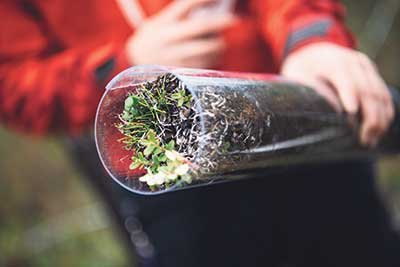Probing ecological change
Research at Wilfrid Laurier University is gauging the health of the boreal biome, an important carbon sink that is storing approximately 30 to 40 per cent of the terrestrial carbon on the planet. Investigators are also looking at the impact of fires that continue to smolder underground. supplied
From zombie fires to global resilience: mapping climate futures at Wilfrid Laurier University
Jennifer Baltzer, an associate professor of biology at Wilfrid Laurier University in Ontario, was living with her family in the Northwest Territories in the summer of 2014 when a “massive, historically unprecedented wildfire season” burned approximately 3.5 million hectares of forest, releasing megatonnes of carbon dioxide into the Earth’s atmosphere.
These extraordinary fires led to “conversations with our partners in the Government of the Northwest Territories (GNWT) and communities in the North about how they would impact northern ecosystems,” says Dr. Baltzer, who is a Canada Research Chair in Forests and Global Change.
She and her team of researchers have been analyzing the impact on forest ecosystems of “climate warming induced disturbances” in Northern Canada.
“We’ve been working to characterize compositional changes in these forests and their implications on future fire behaviour for vegetation and wildlife habitat, and for carbon sequestration potential,” she explains, “all of these functions that ecosystems provide and that change when the forest composition is altered.”
Working in partnership with the fire management division of the GNWT, Dr. Baltzer and her colleagues have begun to gather field data from “zombie” fires, or “overwintering” fires that have been identified as playing a role in the 2014 and 2015 fire season.
“Fires that ignited in 2014 continued smouldering beneath the snowpack through the winter,” she says. “They then reignited the following spring and led to reburning of those sites as well as early season expansion of fire.”
Richard Olsen, manager for fire operations with the GNWT’s Department of Environment and Natural Resources, based in Fort Smith, hopes this research will help inform evidence-based decision-making and policy on fire management in the North.
He points out that fire has always been a part of the ecosystem. However, he is looking to Dr. Baltzer and her colleagues for help in identifying environmental conditions that led to the extreme fire behaviour in 2014.
“Are these events significant enough to be drivers of ecological change?” he says. “We want to understand the movement towards an environment where we could see extreme drought happen more often. We especially have a lot of questions about whether we’re responding in the right way when it comes to helping to protect boreal caribou habitat.”
In looking for answers to some of these questions, Dr. Baltzer’s team has also been investigating permafrost thaw in the boreal biome. “Wildfire accelerates permafrost thaw,” she says. “These compounding disturbances can further modify the forest environment.”
Furthermore, she notes, the boreal biome acts as a carbon sink, storing approximately 30 to 40 per cent of the terrestrial carbon on the planet. “Larger, deeper burning wildfires and increased permafrost thaw both have the potential to release large quantities of carbon into the atmosphere,” she says. “The concern is that the boreal will shift from a carbon sink to a carbon source, which has significant consequences for the global carbon balance.”
Changes in the North, “which is warming four times faster than the global average, are a bit like a canary in the coal mine,” says Dr. Baltzer. “They bring global ramifications. Northern ecosystems are so vital to the health of the planet. We need to pay attention and be actively working to reduce emissions and work toward net zero.”
Meanwhile, those living in the North, says Jonathan Newman, vice-president, research, at Laurier, “are really on the front lines of climate change. Everything they do is viewed through that lens because it’s having such a massive effect on the territory.”
The university, which opened an office in downtown Yellowknife in 2017, remains firmly invested in the Northwest Territories, says Dr. Newman. Laurier and the GNWT recently renewed a formal research and training partnership agreement that extends to 2030.
Through its many research projects, partnerships and connections – from matters related to the environment, education, social issues and food security – Laurier is committed to honouring a “social contract” that will positively affect the region and its people, he says.
“We are busy building long-term relationships through inspired research that has real impact. We want to deliver tangible, social and economic benefits to northern communities.”
To view this report on The Globe's website, visit globeandmail.com
To view the full report as it appeared in The Globe's print edition: Excellence in
research & innovation



